COLLABORATION ON CAMPUS
Design for Public-Private Partnerships



SCB is an architecture, planning, interior and urban design firm. Founded in Chicago in 1931, SCB provides design services from four locations across the US.
SCB is at the forefront of dense urban iving, innovative workplaces, inspiring learning environments, resilient infrastructure, and vibrant communities. Through the collective impact of nearly a century of work, the firm has made an indelible mark on the contemporary landscape.
SCB has designed over 41,000 beds of on-campus student housing. Our portfolio reflects the variety and uniqueness of the institutions we serve and addresses a broad range of needs and building types. From freshman and graduate residences, high-rise and low-rise campus scales, urban and suburban contexts, new facilities and renovated vintage structures - our work offers creative solutions that are tailored to each campus.


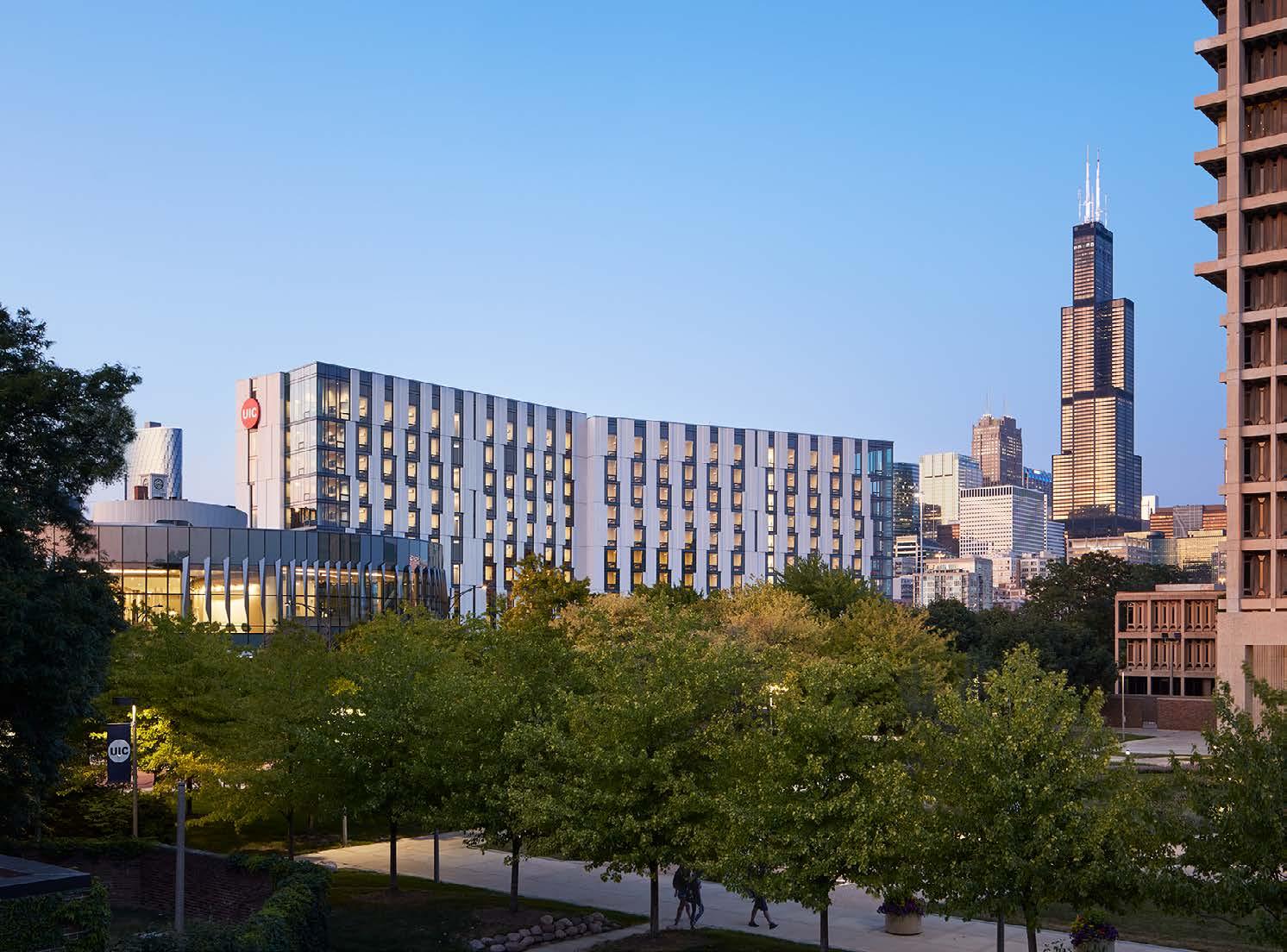
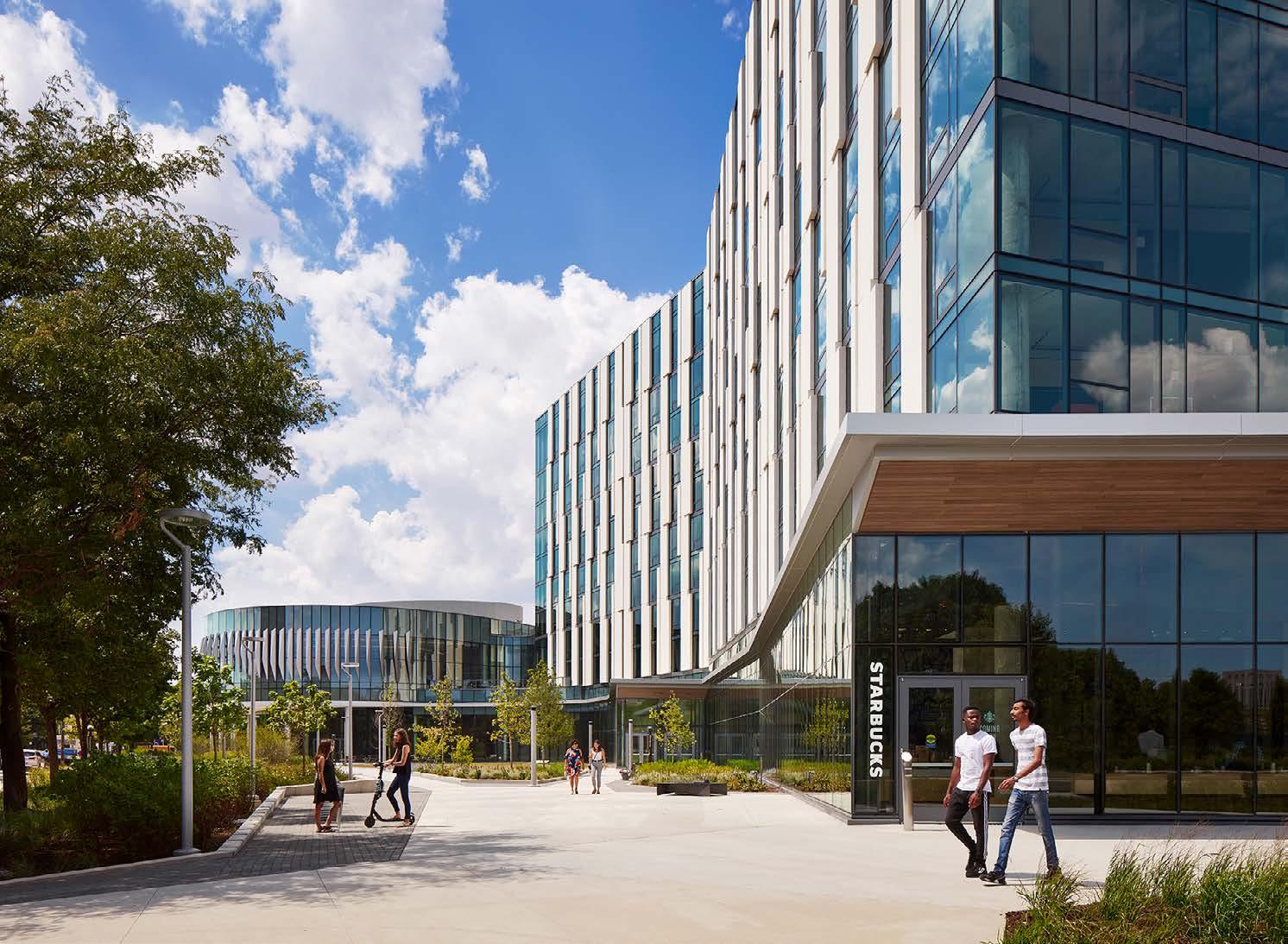
Location: Chicago, IL
Size: 201,000 SF
The Academic and Residential Complex is a new mixed-use building at the University of Illinois at Chicago. Developed through a Public-Private-Partnership (P3), the building is composed of a 52,000-squarefoot, two-story academic classroom building, and 131,000-square-foot, 10-story undergraduate residence hall. Designed with a “nod to Netsch,” the original architect of the campus, the building’s façade and interiors echo the geometric movement expressed in Netsch’s “field theory” and distinctive architecture.
AS CAMPUSES LOOK TO COMBINE PHYSICAL AND CAPITAL RESOURCES, MIXEDUSE BUILDINGS LIKE THE ARC DEMONSTRATE THE OPPORTUNITIES CREATED BY MERGING DISPARATE PROGRAMS INTO ONE FACILITY.
The academic classroom building has large tiered collaborative classrooms arranged in a turn-to-team configuration, two 72-seat active learning classrooms, and two 32-seat flexible classrooms. Break-out spaces are provided throughout the building to encourage collaboration amongst students and help foster faculty-student interactions.


Sustainability was a key design driver from the start of the project. The building is sited in response to optimal solar orientation to mitigate heat gain. Extensive daylight studies with regard to the classrooms helped inform the design of folded aluminum fins along the exterior of the building to allow for maximum natural light while blocking direct glare. The project is certified LEED Gold.



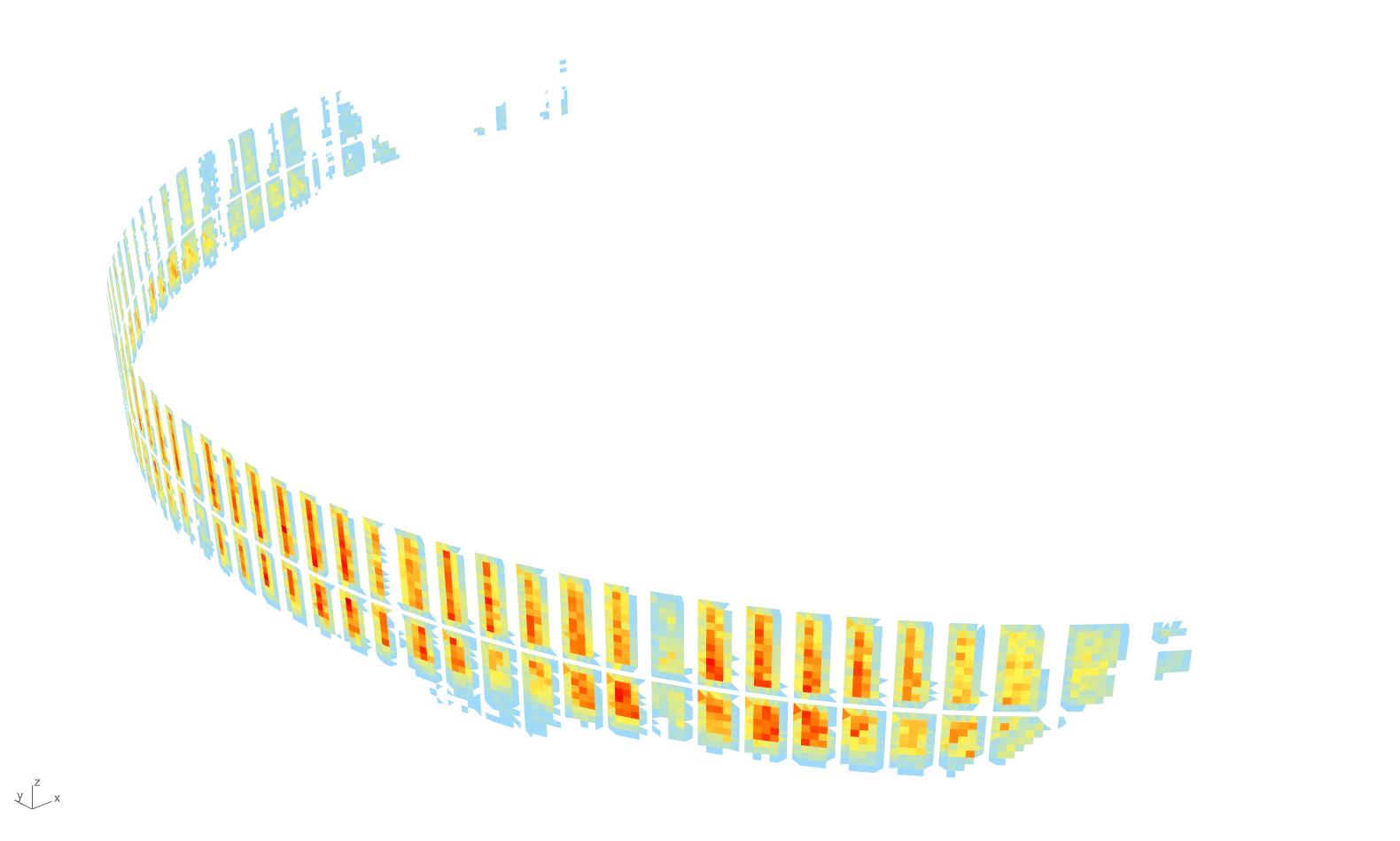

The residential tower includes 554 beds in traditional and semisuite units. Also included are two faculty-in-residence apartments. Shared amenities include study and social lounges on each floor, a fitness center, laundry rooms, and a ground floor Starbucks. The top floor features a sky lounge with commanding views of downtown Chicago, perfect for residential life programming and quiet study.
AWARDS: AIA Education Facility Design Award American Architecture Award, Schools and Universities Category
Student Housing Business Innovator Awards, Best Architecture/Design
Student Housing Business Innovator Awards, Best Implementation of Mixed-Use or Live-Learn
Student Housing Business Innovator Awards, Best New Development by a College, University or Institution
International Interior Design Association (IIDA) Red Awards, Education Award
AIA Chicago Design Excellence Awards, Citation of Merit, Distinguished Building
National Association of Home Builders Multifamily Pillars of the Industry Award, Best On-Campus Student Housing Community
Architizer A+ Awards, Institutional-Higher Education & Research Facilities, Popular Choice Award




Location: Tempe, AZ
Size: 458,000 SF
Tooker House at Arizona State University is a new living/learning community designed to serve freshman engineering students. The seven-story, 458,000-square-foot project includes 1,582 beds for students in semi-suite units, staff apartments, a 525-seat dining hall, a convenience store, numerous dedicated student study and social lounges, and a fitness center. A large maker lab enjoys a prominent and highly visible location on the ground floor of the building, expanding the academic core of the campus and providing residents with space and resources to continue class work and experimental ideas at any time of day. Sliding glass walls allow activities to spill outdoors, where exhibition pedestals enable students to present their work and invite passersby to learn more.
TOOKER HOUSE IS A NEW CAMPUS ANCHOR DESIGNED TO RESPECT THE ENVIRONMENT AND SUPPORT THE STUDENT EXPERIENCE.
AWARDS: SCUP/AIA-CAE Excellence in Architecture for a New Building, Honorable Mention
AIA Chicago Design Excellence Awards, Citation of Merit, Distinguished Building
American Architecture Award
Architizer A+ Awards, Popular Choice Award
Architecture Podium International Architecture Awards First Award – Institutional Building (Built)
Global Architecture & Design Awards Honorable Mention – Institutional (Built)
Multifamily Executive (MFE) Awards Project of the Year – Student Housing
National Association of Home Builders (NAHB), Best in American Living, Student Housing Gold Award
Gold Nugget Awards Grand Winner – Best Student or Faculty Housing, On or Off Campus Residential
Student Housing Business Innovator Award –On-Campus: Best Architecture/Design, Best Use of Green & Sustainable Construction or Development

“THIS MIXED-USE LIVING AND LEARNING FACILITY SETS A NEW STANDARD IN ENGINEERING EDUCATION AND REFLECTS THE BREADTH AND DEPTH OF THE STUDENT EXPERIENCE AT THE LARGEST ENGINEERING SCHOOL IN THE NATION.”

Dean of the Fulton Schools of Engineering

Using the vernacular of desert architecture as its point of departure, SCB created a LEED Gold sustainable building appropriate to its context that could endure, and even leverage, the harsh desert climate of Tempe.
The siting, shape, and massing were developed through extensive shading studies on the constrained campus site. The complex’s figure-eight shape positions the two primary building masses in parallel positions facing east-west, which allows the building to “self-shade” interior courtyards and facades. The southern façade incorporates U-shaped visors and an array of perforated vertical louvers designed and positioned according to a sophisticated algorithm, presenting visual interest and ensuring appropriate daylight control unique to each window’s location on the façade.
The massing also facilitates wind movement through the interior, shaded courtyards, and between the building’s masses. Perforated metal panels on the building’s bridges and breezeways promote airflow through those spaces. Rainwater is harvested from the roof and nourishes select landscape zones in bioswales, reducing the reliance on potable water while also reducing the amount of underground piping and vault infrastructure.



Location: Berkeley, CA
Size: 184,000 SF
David Blackwell Hall is a new residence hall at the University of California Berkeley. Developed through a Public-PrivatePartnership (P3) with American Campus Communities (ACC), the 184,000-squarefoot mixed-use project combines urban planning principles, innovative sustainable systems, and campus design sensibilities to create a unique new addition to both the UCB campus and the South Berkeley community.
The building provides 776 beds of firstyear undergraduate housing organized into a series of pods made up of double occupancy rooms and gender-inclusive bathrooms. Student amenities including an academic success center, fitness center, and entry lounge along with 7,000 square feet of ground floor retail activate Dana and Durant Streets. The building also provides a new home for Stiles Hall, a mission-driven community service organization that has engaged UC Berkeley students for over 125 years.

The project is LEED Gold through a variety of sustainable features and systems focused on reducing energy consumption. Air conditioning is provided only in shared, communal spaces; residential units are served by low velocity, tempered ventilation, which is augmented by operable windows and supplemented by individually controlled electric radiant modules over the windows. Responsive lighting throughout adjusts in brightness according to the amount of natural light infiltrating the building at different points in the day. Blackwell Hall consumes 44% less energy than required by the stringent local code, achieving an energy use intensity of 36 kBtu/square foot. It meets the ambitious energy targets set by the American Institute of Architects’ 2030 Challenge, performing 70% better than similar buildings in the same climate.



Location: Philadelphia, PA
Size: 84,000 SF
Kelly Hall is a case study in how a small, strategic addition can revitalize a whole residential community. Originally constructed in 1967, the 11-story residential tower was designed by Baader, Young, & Schultze. The renovation included a full restoration of the masonry façade, replacement of all windows, and upgrades to all building systems.
The original building basement provided space for student amenities but was dark and hidden from view. By taking advantage of the grade change along the site the design team excavated the lower level, opening the space to natural light. A small 4,000 square-foot addition extends the floor plates of the original ground level and lower level and allows for the creation of a new academic success center, which is open to the full campus community.






A fully glazed double height atrium which features a monumental communicating stair, is linked to a new landscaped outdoor plaza. Academic-focused amenities include larger informal collaborative areas, along with small group meeting rooms and individual study spaces.
The original main entrance to the building remains, now becoming a secure point of entry for residents only. The exterior design of the addition works within the material dialogue of Kelly Hall, utilizing regionally sourced stone and taking cues from the implied lines and geometries within the existing building. A screening element serves dual purposes mitigating thermal gain and solar glare, while also helping to prevent bird strike.
THE EXTERIOR DESIGN OF THE ADDITION WORKS WITHIN THE MATERIAL DIALOGUE OF KELLY HALL, TAKING CUES FROM THE IMPLIED LINES AND GEOMETRIES WITHIN THE EXISTING BUILDING.
Kelly Hall Renovation and Addition
Inside, minimal alterations were made to the residential floorplans; the 410 beds were maintained as traditional doubleoccupancy rooms, while the existing shared community bathrooms were updated to offer private shower and toilet stalls. The residential floors are linked through a series of central, twostory social lounges. Here, the design team took the opportunity to celebrate these communal spaces by replacing the masonry façade with a glass curtainwall, as well as opening visual access to the lounges from the interior through the use of glazing, allowing daylight into the primary circulation path on each floor.
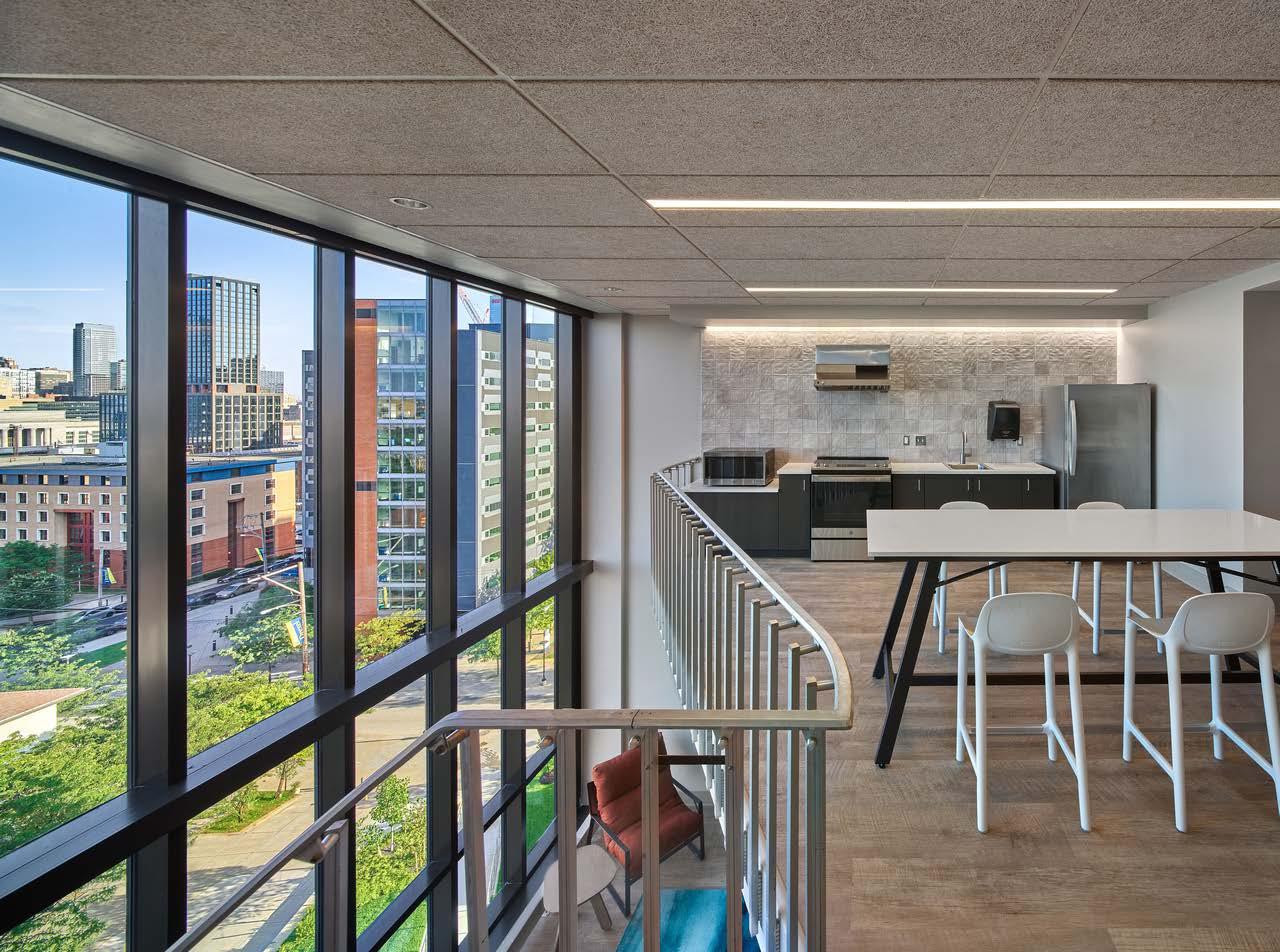

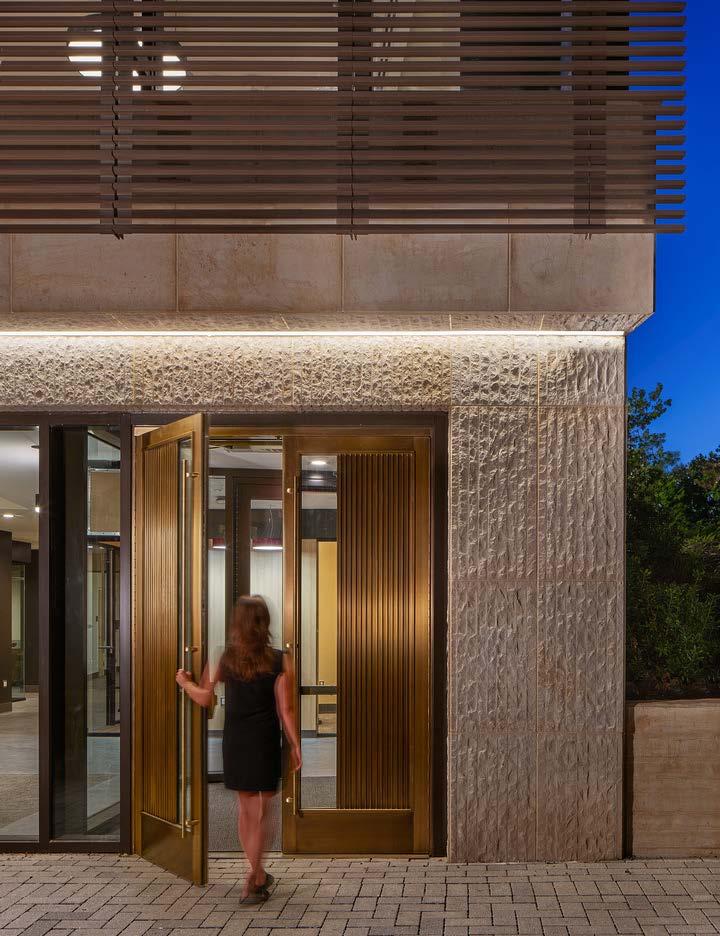

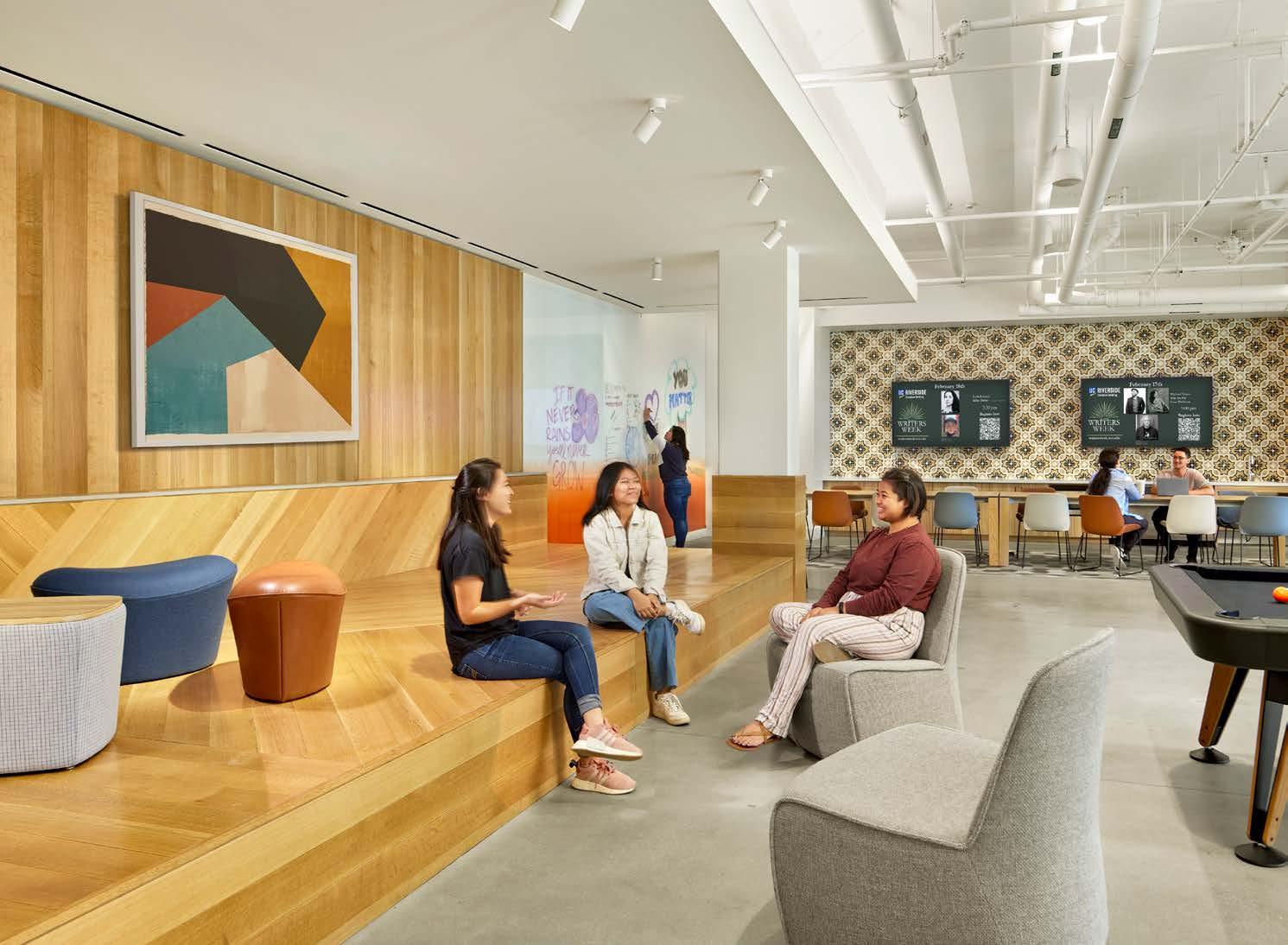
Location: Riverside, CA
Dundee Residence Hall and Glasgow
Dining Commons are the first of several large-scale projects adding residential capacity and transforming the campus experience at UC Riverside. Located adjacent to the campus’ original residence halls, Aberdeen-Inverness (A&I), the 820bed Dundee Residence Hall complements the geometry of A&I, utilizing two sevenstory buildings to form a shared outdoor courtyard. The courtyard serves as the “living room” of the community, offering a variety of recreational and social, as well as contemplative spaces, amidst a landscape of native plantings.
THE BUILDINGS ARE CAREFULLY SITED WITH RESPECT TO NATURAL SIGHTLINES AND CAMPUS CONNECTIONS.
The buildings are carefully sited with respect to natural sightlines and campus connections, with upper floor student lounges strategically positioned as “lanterns” to the community. Ground floor amenities focused on living and learning include three seminar classrooms, a large multi-purpose room, as well as more social spaces such as a large resident lounge with a stage, music practice studios, and a recreation and gaming lounge, to name a few. Dundee Residence Hall is LEED Gold.
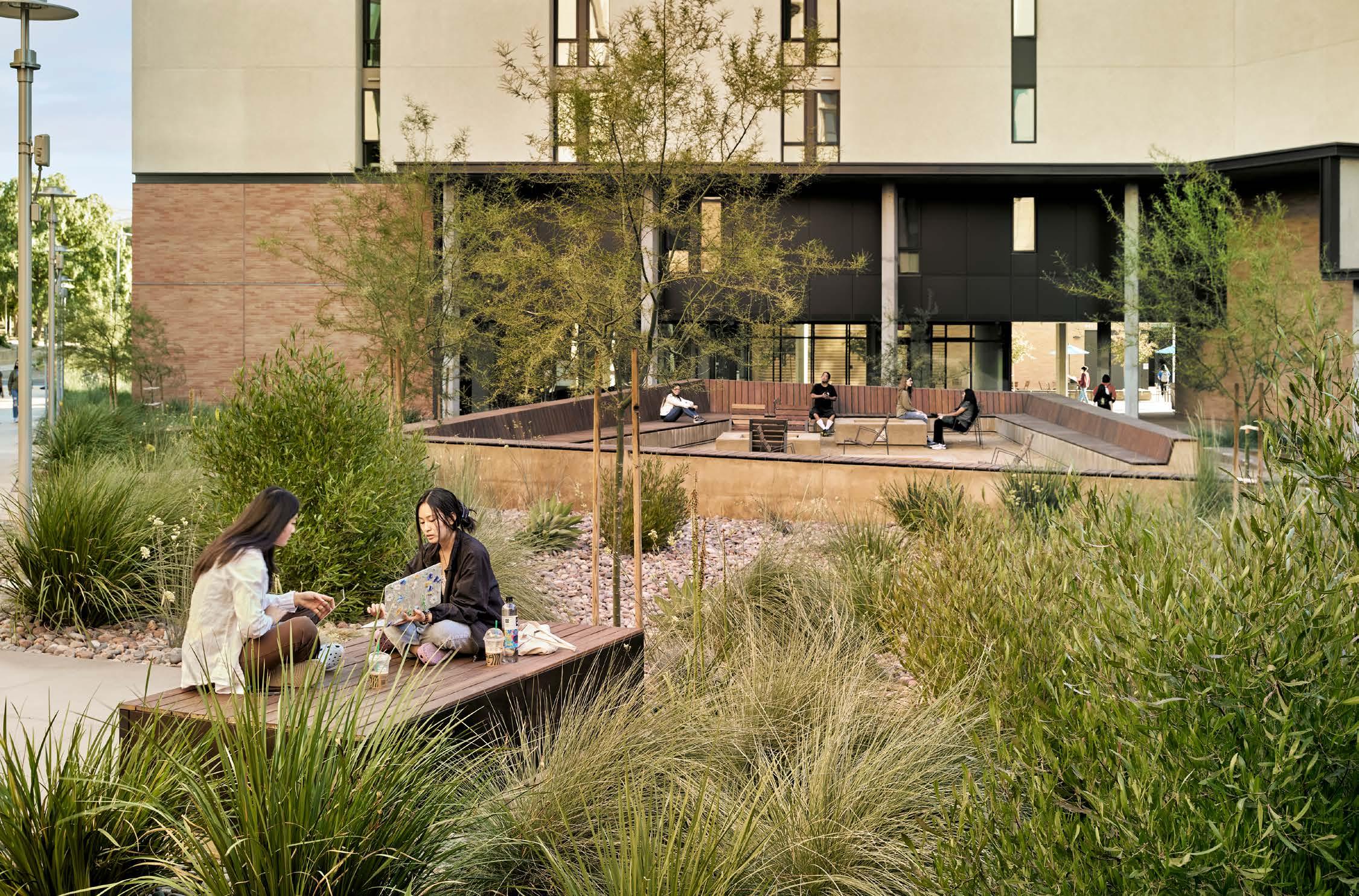
Collaboration on Campus
Dundee Residence Hall and Glasgow Dining Commons
At the courtyard’s southern reach, a large portal through Dundee South Hall reveals the 800+-seat Glasgow Dining Commons, the residential precinct’s signature building. Sweeping walls of glazed curtain wall are shrouded within a louvered shell, allowing for dramatic views of the surrounding Box Spring Mountains, while mitigating solar gain and glare. The 52,000 square-foot all-youcare-to-eat facility offers six unique food venues, including a central demonstration kitchen and exhibition bakery, as well as a grab-and-go convenience store. An elevated outdoor dining terrace provides additional seating, taking advantage of the campus’ hospitable climate, year-round. Glasgow Commons is LEED Silver.



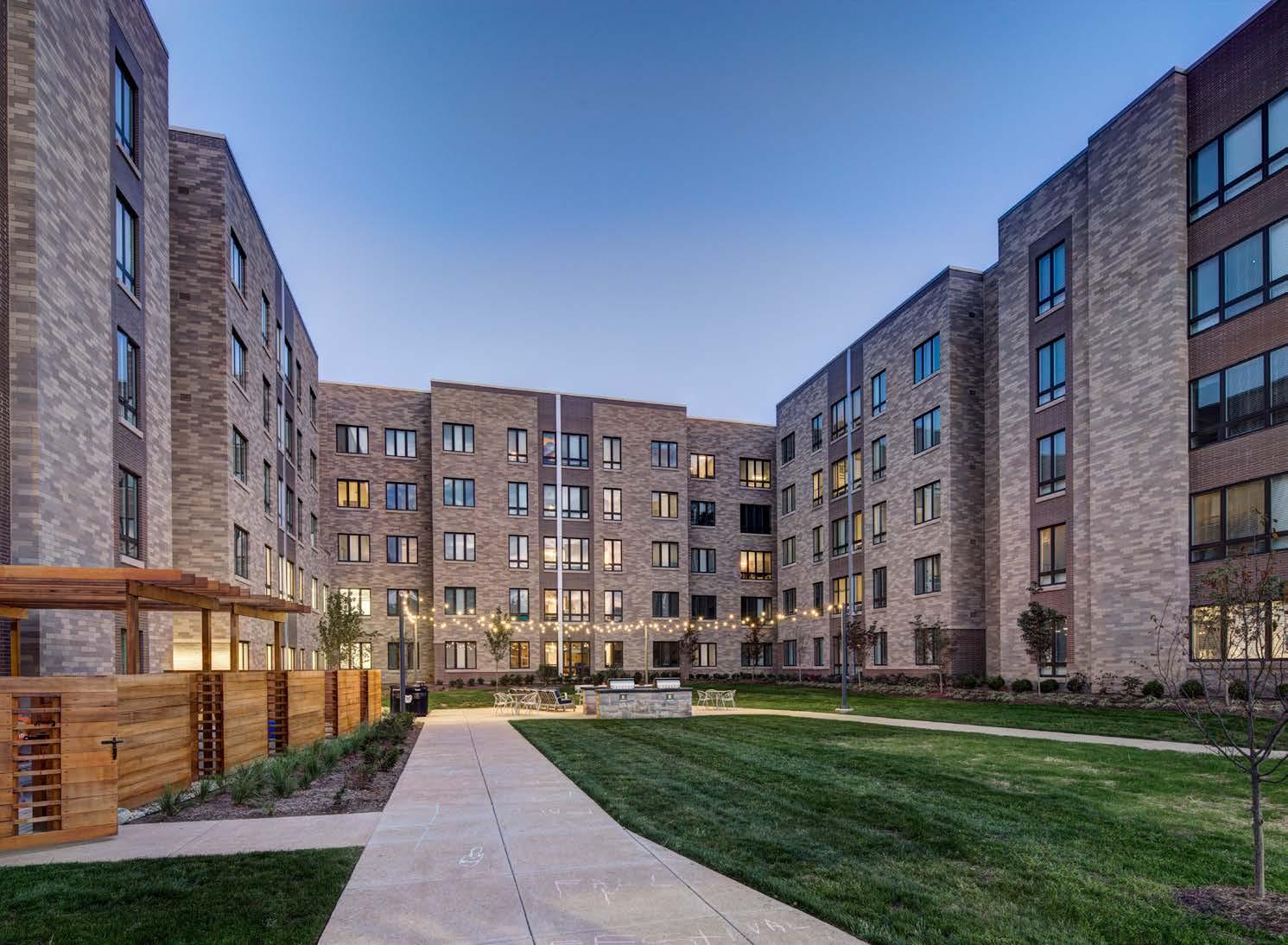
Location: Indianapolis, IN
Size: Fairview House: 210,000 SF; Irvington House: 183,000 SF
After completing a residential master plan for the University, SCB was engaged to design two new residential buildings on Butler’s campus. Both projects were developed through a public-private partnership with American Campus Communities (ACC).
The 633-bed residence hall is organized into a series of smaller, six to eight student pod-style communities. Several new unit plans were created for the project, including a two-story, three-bedroom apartment with an open concept living room and kitchen. The residence hall fosters community-building by offering a variety of spaces that promote interaction. With its social and study lounges, shared laundry facilities, and a fitness studio, the building’s design encourages students to move throughout the building, allowing for encounters with other residents. Two faculty-in-residence units offer students deep mentorship networks and provide possibilities for continued learning beyond classroom walls. The building is LEED Gold.
Located at the main entrance to campus, Fairview House, is positioned along Sunset Avenue, straddling the border between campus and the surrounding neighborhood. To incorporate the building into the broader community, the design team worked extensively with neighborhood residents and community groups to build consensus and gain support for the proposed project. The resulting design provides a modern response to the University’s traditional, collegiate, and gothic context while respecting its surroundings with thoughtful architectural gestures toward neighboring buildings.


Fairview House and Irvington House
Soon to follow was Irvington House, a first-year residence hall adjacent to the University’s student union, Atherton Hall, which offers 647 beds organized in semi-suites. Shared community amenities include social lounges, group study rooms, a fitness center, communal kitchen, and an indoor bike room. A large, ground floor multi-purpose room supports student organizations, Greek chapters, and other campus programming. Two faculty-inresidence apartments provide residents the opportunity for enhanced academic engagement.
Two large campus-facing courtyards provide two distinct outdoor programs: one more social with a fire pit and ample lounge seating and one designed as a quiet, contemplative space. The siting and massing of the building were developed to optimize solar orientation and mitigate heat gain, as well as maximizing opportunities for daylighting within the building. Irvington House is LEED Gold.




Location: Tempe, AZ
211,000 SF
Originally designed in 1967, the 15-story Manzanita Hall was the tallest building in Arizona when it opened. With its unique geometric exterior design the dormitory became an immediate icon on the Arizona State campus. However, after over 40 years of housing more than 40,000 students, the residence hall was in poor condition and no longer served students’ needs. ASU hired SCB to conduct a feasibility study to explore renovation or replacement strategies for the 810bed residence hall. The study revealed that replacement would be a far easier undertaking; however, the University ultimately decided to renovate the building due to its iconic character and the importance of its place in the memories of alumni. ASU retained SCB and Studio Ma to work with American Campus Communities to complete a full renovation of Manzanita Hall.
The new exterior enclosure system was designed to work with the existing structural bracing system expressed on the exterior of the building. By eliminating the existing infill windows and wall panels and setting the new exterior wall behind the structural braces, the design team visually accented the iconic braces, giving the building a more crisp graphic character. This solution also allowed for the new enclosure to run uninterrupted behind the braces and consequently perform at a higher thermal efficiency.

The renovation sought to improve physical and social connections, increase natural light into the building, and integrate technologies for today’s increasingly connected students. The design team found an opportunity to add two-story communal lounges and kitchens within new “found space” by extending the original northwest exterior wall to the L-shaped shear walls and adding floor-to-ceiling glass. The original exterior bracing is now part of the interior, demarcating each lounge’s mezzanine.
Working within the constraints of the existing building, the design team reconfigured the floor plans to accommodate a more efficient layout, consisting of suites of two double-occupancy rooms with a shared bathroom. Significant physical surveying and space planning ensured that the new floor layouts for suites and bathrooms did not interfere with the building’s existing structural elements. The planning of the new plumbing chases faced challenges due to existing post-tension slabs and interior shear walls, which could not be eliminated or encroached upon.
The decision to reuse the building established the University’s commitment to sustainability, which became a priority for the project. The project has achieved LEED Silver.


AWARDS: SCUP/AIA-CAE Excellence in Architecture for Restoration or Preservation - Honor Award
Student Housing Business Innovator Award, On-Campus: Best Renovation of Existing Dorm
AIA Arizona Distinguished Building Honor Award

“THIS WAS A FOREBODING TECHNICAL REDEVELOPMENT OF A STRUCTURE THAT PROBABLY SHOULD HAVE BEEN DEMOLISHED. EVERYONE ON THE PLANNING TEAM WAS PETRIFIED OF THE RISKS AND UNFORESEEN ASSOCIATED WITH THE BUILDING.
THE SCB TEAM WAS CREATIVE, PIONEERING AND THOROUGH, AND LED AN AMAZING PROJECT TEAM. THE PROJECT WAS DELIVERED ON TIME, UNDER BUDGET AND 100 PERCENT LEASED.”
JASON WILLS
American Campus Communities



Location: Riverside, CA
Size: 534,000 SF, 1,500 beds
The North District is a new 50-acre living-learning district at UCR that, when complete, will transform the campus life experience for this growing university. Consistent with UCR’s Long Range Development Plan, the University identified a low-density and functionally obsolete expanse campus for this ambitious and transformational project. The North District Master Plan calls for the creation of 6,000 beds of student housing to address UCR’s substantial projected increase in student enrollment by 2030. Drawing from a more urban-style approach to planning, the mixed-use North District will feature a multitude of facilities in addition to housing, including a dining commons, plazas, academic spaces, outdoor recreation, and a sports venue.
Phase One of the project is a 1,500-bed upper-division undergraduate apartment community at the terminus of Aberdeen Street onto Linden Street, both major campus thoroughfares. The project is organized into six massings fronting a large, open paseo that visually extends the Aberdeen Mall as a pedestrian-only public space with various gathering areas. The paseo is activated by the diverse program elements of the ground floors of the buildings which include classrooms, a small café, fitness center, resident study and social lounges, and the leasing and residence life office.
The geometries of the various buildings create three character-defining outdoor courtyards, befitting the region’s high desert climate. The southeast courtyard offers a quieter environment for study and rest and is noted by a multitude of hammocks. The northeast courtyard is a mostly green space centered on a terraced grass berm. The western courtyard, the largest of the three, offers shaded seating areas and a recreation lawn, along with access to the fitness center.
The project is all-electric; the first student housing project to be so on campus. Extensive shading studies informed the siting of the buildings to facilitate selfshading of the facades and courtyards over the course of the day. Water usage by occupants is reduced through low-flow plumbing fixtures. Outside, a landscape of drought tolerant and native plantings is minimally maintained by an efficient lowwater irrigation system.

THE ALL-ELECTRIC, LEED GOLD PROJECT
COMBINES PASSIVE SUSTAINABLE DESIGN STRATEGIES WITH INNOVATIVE BUILDING SYSTEMS.


Location: Philadelphia, PA
Size: 585,000 SF
Developed in partnership with Drexel University and American Campus Communities, this 1,315-bed, 24 story tower blends the principles of high-rise design with the unique needs of student residents. SCB drew from the firm’s extensive experience in the high-rise residential market to design efficient floor plans that maximize views to the city and campus and incorporate a variety of 2-4 bedroom apartment and suite style units. The building responds to the character of the adjacent Powelton Village neighborhood with a low-rise retail storefront base that enhances the pedestrian experience on Lancaster Avenue, while rising to a tower in relation to the higher density University City towards campus.
The design team sought to activate the ground level of the building, emphasizing community spaces including a lobby lounge connected to a Starbucks, recreation and fitness center, theatre, cyber lounge, group study rooms, and business and mail center.
AWARDS: NAHB Multifamily Pillars of the Industry – Best Student Housing Rental Apartment Community
Urban Land Institute Philadelphia – Willard G. “Bill” Rouse III Award for Excellence


As an addition to both the university campus and the greater University City neighborhood, ACC and Drexel recognized that the building should provide amenities to students and members of the broader community alike. To address that need, the building offers Urban Eatery, a full service dining facility that is open to the public. Urban Eatery features a variety of dining options including numerous themed eateries and a late night grab and go café. With the iconic dining pavilion and an engaging entry plaza, The Summit is a new hub of student life within University City.






Location: Tempe, AZ
Size: 265,000 SF, 820 beds, 350 seats dining
The Herberger Institute for Design and the Arts (HIDA) Living/Learning community exemplifies how an innovative mixeduse campus project can create a unique residential experience and support student needs in a distinct educational program. By blending spaces for living, learning, dining, and making, the tailor-designed building offers opportunities for both artistic exploration and social growth. The design is rooted in the notions of porosity and activation, which serve as foundational elements of the project.
The massing of the buildings combines a strong urban edge with a large campusfacing portal leading to an internal activated plaza, which serves as a central nexus for the mixed-use program. A dynamic lilac ceiling plane weaves together the various outdoor and indoor program elements, creating a fluid and engaging user experience through the site and buildings.
The exterior design for the project is a layered study of materials inspired by the natural desert environment. Complementing the subtle palette, iridescent, perforated metal fins and screens animate the façade and create an expressive identity for the building in the otherwise modest campus edge context. They also serve in a functional capacity, mitigating solar exposure and providing privacy for the residences. The project is targeting LEED Gold.
“OUR DESIGN FOR HIDA IS REALLY GROUNDED IN THE NOTIONS OF ACTIVATION AND POROSITY, AND HOW THOSE ELEMENTS CAN FOSTER COMMUNITY BUILDING AND THE OVERALL WELLBEING OF STUDENTS, AS WELL AS CREATE AN ENERGY THAT SUPPORTS THEIR ARTISTIC PRACTICE.”
MICHAEL THOMPSON, AIA, LEEP AP Principal, SCB


THE EXTERIOR DESIGN IS A LAYERED STUDY OF MATERIALS INSPIRED BY THE DESERT ENVIRONMENT. COMPLEMENTING THE SUBTLE PALETTE, IRIDESCENT, PERFORATED METAL FINS AND SCREENS ANIMATE THE FAÇADE AND CREATE AN EXPRESSIVE IDENTITY FOR THE BUILDING.
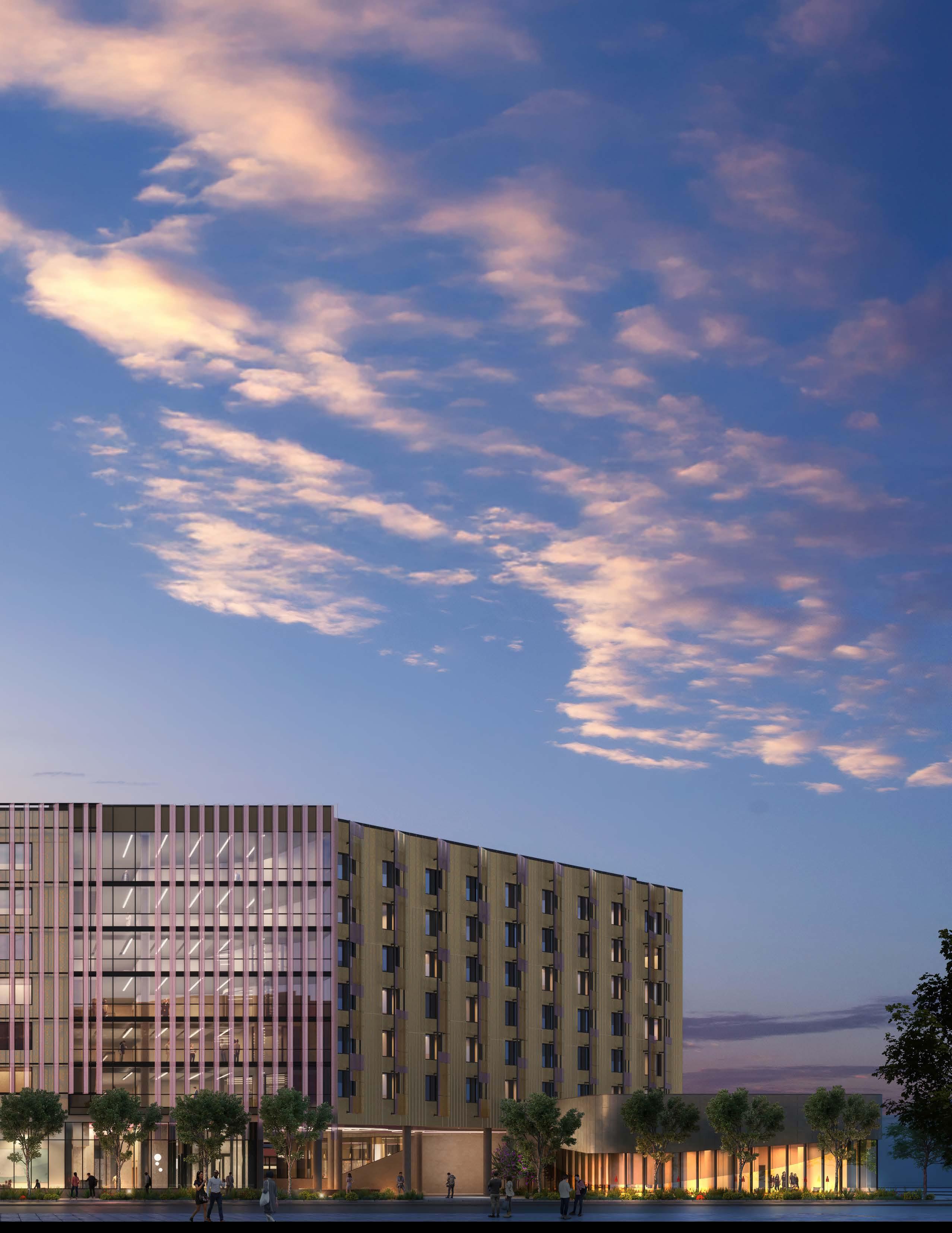
Entering the residence hall from the plaza, a lobby gallery space adorned with student work sets the stage for a living/ learning community in support of the arts. An adaptable, centralized studio with movable furniture is surrounded by a series of enclosed workrooms. The connection to the outdoors remains uninterrupted through the floor-to-ceiling glazing, which creates a seamless blend between inside and outside. Moving upward, the residence hall comprises 820 beds organized into semi-suites, punctuated by communal spaces including two-story lounges, where spaces more social in nature, such as shared kitchens, coexist with quieter areas dedicated to focus and study.


Extending from the plaza towards campus is an 11,000-sf structure for the Herberger Institute for Design and the Arts. The building stands as an artistic haven, housing a dance studio, stop-motion studio, and a printing and paper-making studio and garden. Tucked under the mass of the building, a 350-seat dining hall along with a 100-person multipurpose room completes the mixed-use program, offering a variety of venues and seating areas beneath a large sculptural mesh chandelier installation.



Location: West Lafayette, IN
Size: 328,000 SF, 640 beds
3rd and West is a new student apartment community in Purdue’s Discovery Park District, a burgeoning mixed-use and interdisciplinary innovation district in West Lafayette. Delivered through a publicprivate partnership between the Purdue Research Foundation and American Campus Communities, the project provides housing for 640 upper-division students in a variety of unit types, ranging from studios to four-bedroom apartments. All units feature bedroom-to-bathroom parity, allowing apartments to be leased in their entirety or by the bed.
The building’s dynamic form establishes a public plaza at the corner of 3rd and McCormick, serving as a space for District activities like markets and game day events. Beyond the plaza, the residential entry and lobby flow into the community’s primary amenity space. This amenity “bar” defines two unique internal outdoor courtyards; the north being more public in nature with spaces for larger gatherings and the south more private with a hammock grove.
As one of the first projects utilizing the district’s design guidelines, adopting more urban design principles and providing a safe and vibrant street edge were key drivers for the architectural design. Along McCormick Road, a major arterial street and primary bike route between the district and adjacent campus, a generous set back from the street edge allows for an expanded bike lane and sidewalk. The addition of ample lighting and native landscaping makes this a safe and inviting route. In the architecture itself, shifts in the depth of the building’s façade along with strategic use of glazing break down the building’s scale by bringing texture and rhythm to its long street frontages. The materiality of the building with its Norman brick, warm-hued grey metal, and bright/ cream-colored panels/fiber cement board establishes a warm, contemporary character.


“IN DESIGNING 3RD AND WEST, WE SAW THE OPPORTUNITY TO USE ARCHITECTURE TO CREATE AND SHAPE A UNIQUE OUTDOOR COMMUNITY SPACE.”
MONICA WILLEMSEN, AIA, NOMA, LEED AP, CPHC Associate Principal, SCB

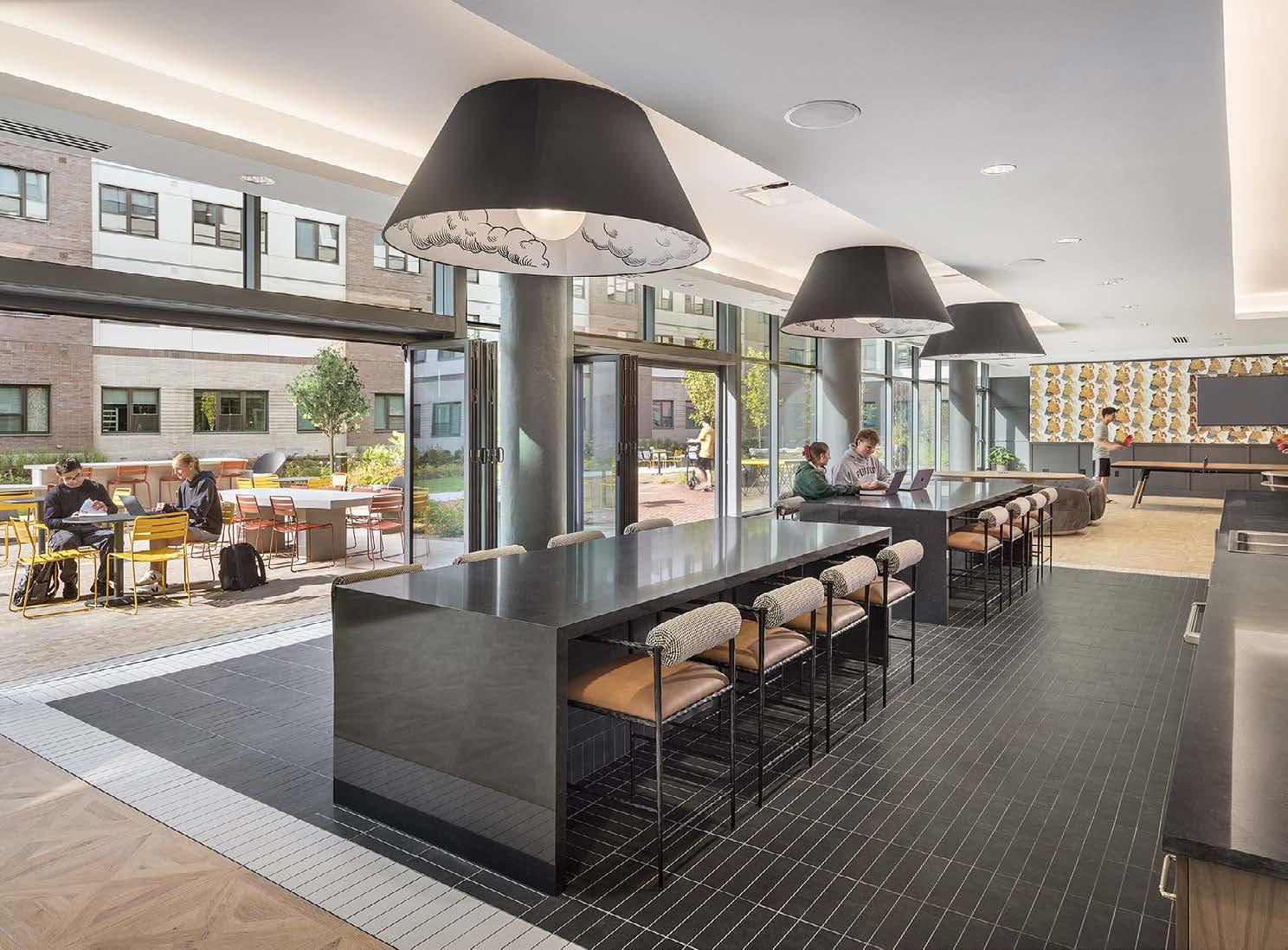

Floor-to-ceiling glazing visually connects the two courtyards through the amenity space, blurring the lines between the indoors and outdoors. Amenities include indoor and outdoor kitchens, social and study lounges, private study rooms, and a fitness center. Residential floor study lounges stack the full height of the building at the entry plaza, their glowing light and bold wall graphics becoming a visual marker for the community and Discovery Park District as a whole.

3rd



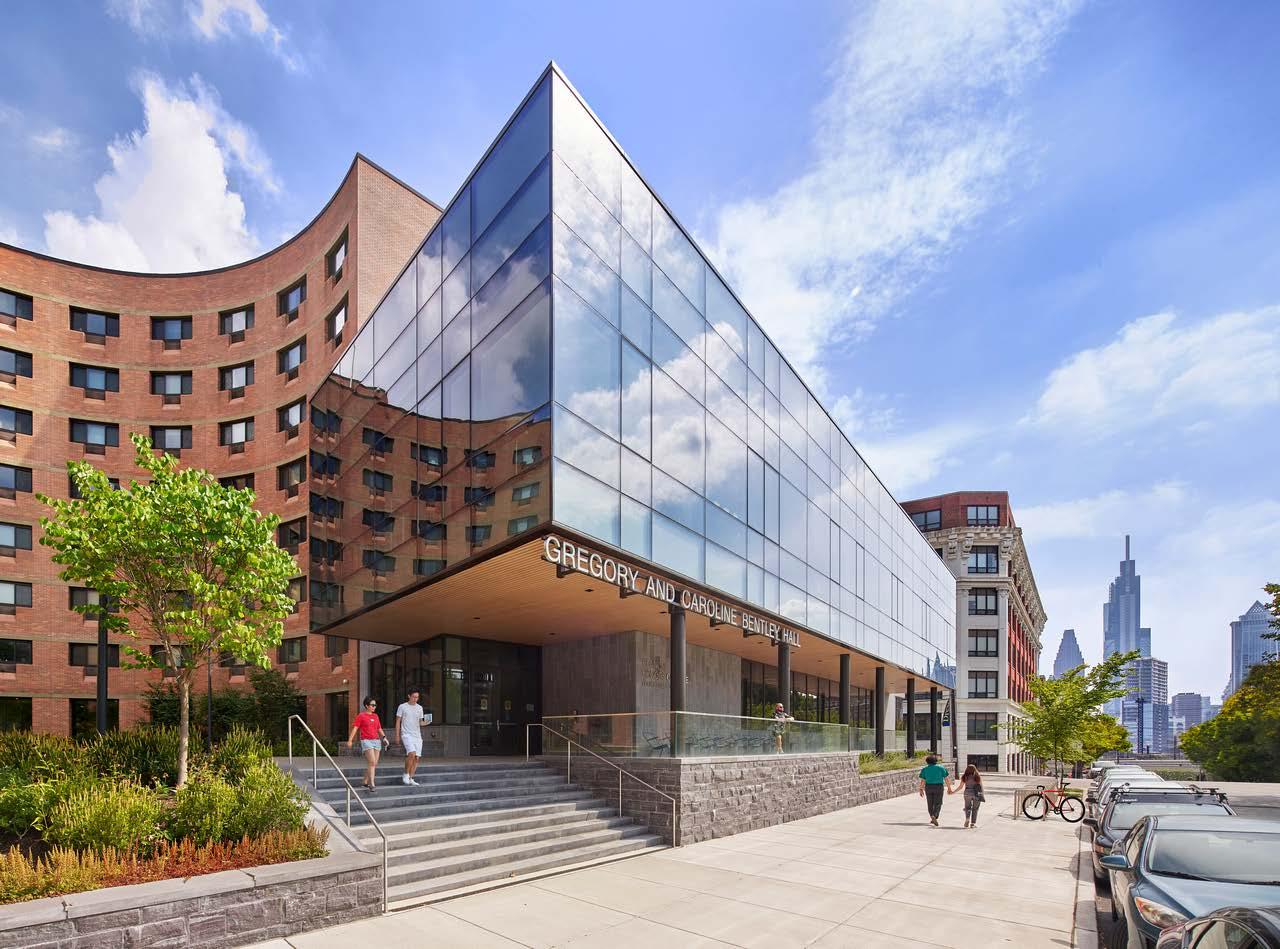
Location: Philadelphia, PA
Size: 94,000 SF, 406 beds (Renovation) 11,000 SF (Addition)
Originally constructed in 1969, Bentley Hall at Drexel University typified a common challenge faced by many universities: a large, in this case 406-bed, residence hall that was outdated and no longer serving the needs of students. At the same time, Drexel’s Pennoni Honors College was thriving, yet lacked a residential component to round out the program. SCB was selected as the architect and interior designer for a full renovation of the existing Bentley Hall and an 11,000-square-foot academic addition to serve as the new home for the Pennoni Honors College.
Following the necessary replacements and upgrades to the building systems, the renovation of Bentley Hall prioritized spaces that would have the highest impact on the residents. Room types, bathrooms, and layouts were maintained on the residential floors and merely refreshed with new finishes, fixtures, and furniture. Lounges adjacent to the elevators were added to each floor and alternate between social and study uses to help build a sense of community amongst residents.
The ground floor was where the largest impact was made with a complete reconfiguration to accommodate a new student lounge, quiet study space, a community kitchen, and staff offices. The interior design for the space takes cues from the original mid-century vintage of Bentley Hall including exposed brick walls, modern furniture, and lighting inspired by the era.



The new addition provides the Honors College with a new identity and is differentiated from the larger Bentley Hall through a modern stone and glass architectural expression. A front porch extending the length of the addition enlivens the Arch Street façade with outdoor seating and an unobstructed visual connection to the interior spaces.
The ground floor houses three seminar rooms, quiet study space, and a “living room” for the honors college. This rich, programmatic mix provides abundant options for students and faculty to gather. The second floor houses a suite of offices for faculty and Honors College staff, organized around a central shared lounge.

THE NEW HOME FOR THE PENNONI HONORS COLLEGE OFFERS A RICH, PROGRAMMATIC MIX THAT PROVIDES ABUNDANT OPTIONS FOR STUDENTS AND FACULTY TO GATHER.




Location: Berkeley, CA
Size: 170,000 SF
SCB is designing the Upper Hearst Development for University of California, Berkeley. The development consists of a 132-unit market rate apartment building for faculty and staff and expansion to the Goldman School of Public Policy (GSPP). The project is being delivered as a PublicPrivate-Partnership (P3) and is projected to reach LEED Gold.
The residential portion includes the adaptation and reuse of the existing Upper Hearst parking structure and embraces its corner site with dynamic architectural gestures at both intersections. With a gracious main entry at the corner of La Loma and Ridge, the building massing steps in sync with the natural topography of the site. The exterior character is a contemporary complement to the Second Bay Tradition, utilizing cedar siding, expressed structure, and studied layering of the façade elements. Due to the structural upgrades required to reuse the parking garage, the addition of new shear walls provided an opportunity to refresh the character of the garage using board-formed concrete, a timber screening element to conceal the open portions of the garage, and landscape screening to help fill the voids. The residential portion offers studios; one-, two- and three-bedroom units; a fitness center; multi-purpose room; and rooftop lounge/terrace.
The GSPP is a 36,000-square-foot, five-story facility designed to support the School’s innovative educational program and collaborative community spirit. Its prominent placement along Hearst Avenue establishes an visible identity for the School and a new entry to the GSPP quad. Major program elements are made visible through liberal use of glass, while the building’s more solid masses, clad in cedar siding and board-formed concrete, respond to the scale and materiality of the surrounding context. The building’s program includes a 250-seat divisible classroom, seminar classrooms, faculty and shared graduate student offices, all centered around a living room. The living room is a three-story atrium overlooking a new outdoor plaza that serves as a central gathering space for the Goldman School. The atrium’s ceiling will be glazed with an integrated photovoltaic array, providing both glare control and energy generation. An elegant stair punctuates the atrium, while a cafe further activates the space. The top level of the building boasts a roof deck with views of the Bay and Golden Gate Bridge.




Location: Toledo, OH
Size: 142,000 SF, 492 beds
The Honors Academic Village is a new living/learning community designed to meet students’ social needs while fostering academic success. The new 142,000-square-foot, four-story residence hall provides 492 beds, helping to advance the University of Toledo’s strategic goal to modernize its housing portfolio and support the recruitment and retention of its brightest students.
The University entrusted the SCB team with a site located adjacent to the historic campus core and challenged the firm to design a building that would respect the existing campus context. The siting of the building was developed in relation to the neighboring historic residential colleges. The design team saw an opportunity to create a village green to be shared by all residents in the area by splitting the building into two wings linked by a central circulation core and opening it up to its historic neighbors. The village green is surrounded by the residence hall’s active and transparent ground floor, featuring a learning commons, a state-of-the-art fitness center, and lounges for recreation and socialization.

The building is organized into a series of neighborhoods and offers an array of one to four bedroom units in various sizes and layouts. A social lounge with a fireplace and private study lounges are located at the core of each neighborhood. By breaking down the larger building into smaller neighborhoods, the design of the residence hall encourages interaction between residents and fosters a sense of community.